Micron C400 mSATA (128GB) SSD Review
by Anand Lal Shimpi on April 10, 2012 8:00 AM ESTAnandTech Storage Bench 2011
Two years ago we introduced our AnandTech Storage Bench, a suite of benchmarks that took traces of real OS/application usage and played them back in a repeatable manner. I assembled the traces myself out of frustration with the majority of what we have today in terms of SSD benchmarks.
Although the AnandTech Storage Bench tests did a good job of characterizing SSD performance, they weren't stressful enough. All of the tests performed less than 10GB of reads/writes and typically involved only 4GB of writes specifically. That's not even enough exceed the spare area on most SSDs. Most canned SSD benchmarks don't even come close to writing a single gigabyte of data, but that doesn't mean that simply writing 4GB is acceptable.
Originally I kept the benchmarks short enough that they wouldn't be a burden to run (~30 minutes) but long enough that they were representative of what a power user might do with their system.
Not too long ago I tweeted that I had created what I referred to as the Mother of All SSD Benchmarks (MOASB). Rather than only writing 4GB of data to the drive, this benchmark writes 106.32GB. It's the load you'd put on a drive after nearly two weeks of constant usage. And it takes a *long* time to run.
1) The MOASB, officially called AnandTech Storage Bench 2011 - Heavy Workload, mainly focuses on the times when your I/O activity is the highest. There is a lot of downloading and application installing that happens during the course of this test. My thinking was that it's during application installs, file copies, downloading and multitasking with all of this that you can really notice performance differences between drives.
2) I tried to cover as many bases as possible with the software I incorporated into this test. There's a lot of photo editing in Photoshop, HTML editing in Dreamweaver, web browsing, game playing/level loading (Starcraft II & WoW are both a part of the test) as well as general use stuff (application installing, virus scanning). I included a large amount of email downloading, document creation and editing as well. To top it all off I even use Visual Studio 2008 to build Chromium during the test.
The test has 2,168,893 read operations and 1,783,447 write operations. The IO breakdown is as follows:
| AnandTech Storage Bench 2011 - Heavy Workload IO Breakdown | ||||
| IO Size | % of Total | |||
| 4KB | 28% | |||
| 16KB | 10% | |||
| 32KB | 10% | |||
| 64KB | 4% | |||
Only 42% of all operations are sequential, the rest range from pseudo to fully random (with most falling in the pseudo-random category). Average queue depth is 4.625 IOs, with 59% of operations taking place in an IO queue of 1.
Many of you have asked for a better way to really characterize performance. Simply looking at IOPS doesn't really say much. As a result I'm going to be presenting Storage Bench 2011 data in a slightly different way. We'll have performance represented as Average MB/s, with higher numbers being better. At the same time I'll be reporting how long the SSD was busy while running this test. These disk busy graphs will show you exactly how much time was shaved off by using a faster drive vs. a slower one during the course of this test. Finally, I will also break out performance into reads, writes and combined. The reason I do this is to help balance out the fact that this test is unusually write intensive, which can often hide the benefits of a drive with good read performance.
There's also a new light workload for 2011. This is a far more reasonable, typical every day use case benchmark. Lots of web browsing, photo editing (but with a greater focus on photo consumption), video playback as well as some application installs and gaming. This test isn't nearly as write intensive as the MOASB but it's still multiple times more write intensive than what we were running in 2010.
As always I don't believe that these two benchmarks alone are enough to characterize the performance of a drive, but hopefully along with the rest of our tests they will help provide a better idea.
The testbed for Storage Bench 2011 has changed as well. We're now using a Sandy Bridge platform with full 6Gbps support for these tests.
AnandTech Storage Bench 2011 - Heavy Workload
We'll start out by looking at average data rate throughout our heavy workload test:
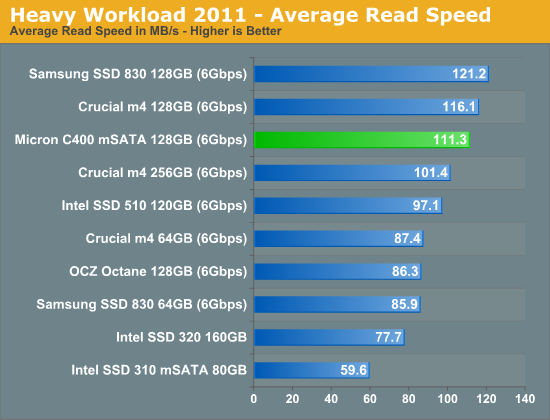
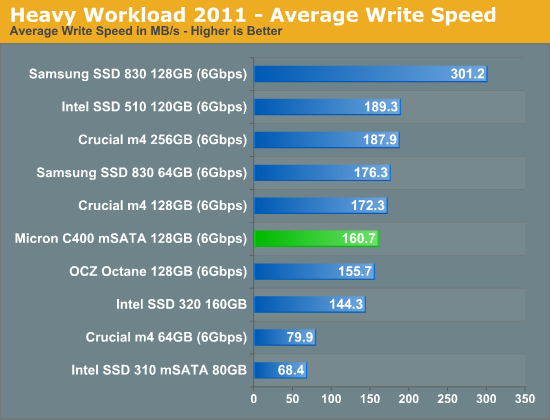
The next three charts just represent the same data, but in a different manner. Instead of looking at average data rate, we're looking at how long the disk was busy for during this entire test. Note that disk busy time excludes any and all idles, this is just how long the SSD was busy doing something:
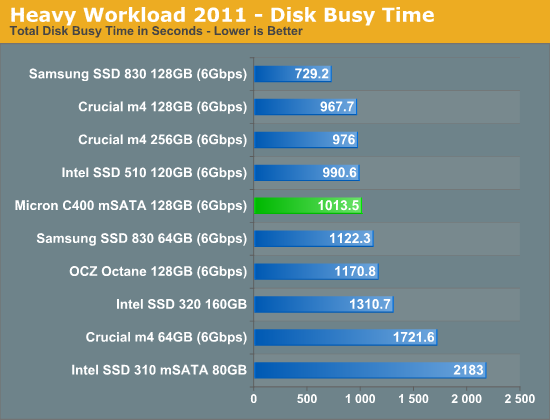

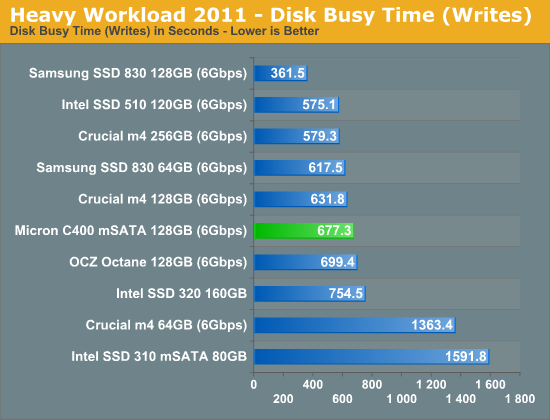


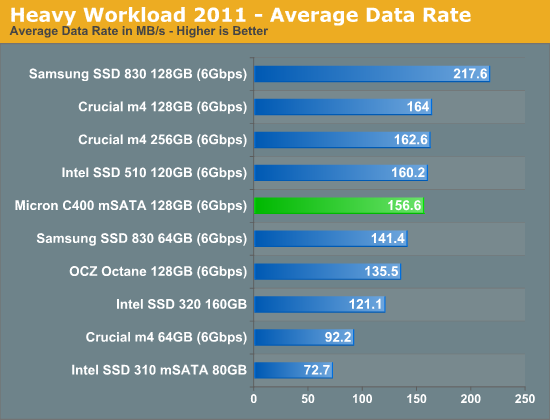








47 Comments
View All Comments
shaik umair - Friday, April 20, 2012 - link
ya an can get it.... cal me @ 09032293363..........just pay me rupees 2400 for 128gb and rupess 3300 for 500gbConficio - Tuesday, April 10, 2012 - link
Thanks Anand,for presenting this new technology and testing it out. As it is so new, it would be good to hear what platforms, i.e. laptops, motherboards, extension cards do offer support for this mSATA technology.
Meaker10 - Tuesday, April 10, 2012 - link
I know the new Gene from Asus will and GT60 and GT70 (with the right attachment) MSI notebooks.Penti - Tuesday, April 10, 2012 - link
It's not that new. It's been around a year and some notebooks uses it. There is also mSATA > SATA 2.5" adapters. Some Ultraportables uses mSATA too. Like Dell XPS 13 or HP Folio 13. Those would be kinda hard to upgrade since they are not really serviceable though. But possible and easy to varying kinds of degree.Motherboards and other stuff has started using it too of course. But they appear to be SATA2/300 on the mSATA port only. Not sure what system they use to bench the drives here. Probably using a desktop system with a adapter.
critical_ - Wednesday, April 11, 2012 - link
I've been using an Intel 310 mSATA in my Lenovo W520 (i7-2960XM, 32GB of RAM, nVidia Quadro 2000M w/ 2GB) and it's served me well. I'd love a slightly faster and bigger mSATA drive so the 256GB version may be it for me. I'm a bit confused as to why Intel has not released much larger mSATA drives yet.Penti - Wednesday, April 11, 2012 - link
There are plenty of other vendors though. Micron/Crucial as article, Samsung, SanDisk, even Toshiba and players like OCZ and Plextor/Liteon too. They all have 256GB /mSATA SSD drives. Intel doesn't seem to see them as proper system drives, much of their mSATA lineup is touted against RST, Microsoft ReadyBoost. Like companies such as Kingston, ADATA etc specifically turns against those.Normally many workstation lappys supports mSATA now days, I think the list for some of those goes like Lenovo X220/T420/T420s/W520 (plus others) and on Dell M4500/M4600/M6400/M6500/M6600. Some Toshibas and Sony is also using it.
The 310s are just using 34nm NAND and old Intel controller to begin with. It's all much higher density now. Those larger drives at the time used many more chips and channels to the controller.
Casper42 - Saturday, April 14, 2012 - link
Take a look at the recent Z77 Mobo roundup for the upcoming Ivy Bridge release.Lots of boards there will starts to use it.
I wouldn't be surprised to see Laptops with the same connector in 2 months when Ivy Bridge goes mobile either.
Iketh - Tuesday, April 10, 2012 - link
A refreshingly pleasing article to read :DI couldn't tell by the article if this drive plugs into a pcie slot and you need an adapter for sata or vise versa, or if i'm even sane in thinking this is possible...
Meaker10 - Tuesday, April 10, 2012 - link
mSATA ports are shaped like mini PCI-e ports and are needed to plug these in. They are in some netbooks already and the new wave of intel motherboards will find a few on there.kensiko - Tuesday, April 10, 2012 - link
Considering this SSD would fit well in laptops or ultrabooks, the power consumption is pretty high, too bad.